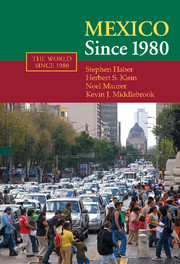Book contents
- Frontmatter
- Contents
- List of Figures
- Acknowledgments
- Abbreviations and Acronyms
- 1 The Second Mexican Revolution: Economic, Political, and Social Change Since 1980
- 2 Mexico Before 1982: The Political Economy of Authoritarian Rule
- 3 The Causes and Consequences of Free Trade
- 4 The Mexican Banking System: The Politics and Economics of Financial Underdevelopment
- 5 The Transformation of Mexican Politics
- 6 Health, Education, and Welfare in Mexico Since 1980
- 7 Democracy and Development in Mexico: Future Challenges and the Legacies of Authoritarian Rule
- Bibliography
- Index
3 - The Causes and Consequences of Free Trade
Published online by Cambridge University Press: 05 September 2012
- Frontmatter
- Contents
- List of Figures
- Acknowledgments
- Abbreviations and Acronyms
- 1 The Second Mexican Revolution: Economic, Political, and Social Change Since 1980
- 2 Mexico Before 1982: The Political Economy of Authoritarian Rule
- 3 The Causes and Consequences of Free Trade
- 4 The Mexican Banking System: The Politics and Economics of Financial Underdevelopment
- 5 The Transformation of Mexican Politics
- 6 Health, Education, and Welfare in Mexico Since 1980
- 7 Democracy and Development in Mexico: Future Challenges and the Legacies of Authoritarian Rule
- Bibliography
- Index
Summary
The Institutional Revolutionary Party (PRI) was fortunate that the presidential election held in July 1982 took place before the government announced a debt moratorium in August and nationalized private banks in September. For several decades the party had sought to legitimate its monopoly on power on the basis of Mexico's record of sustained economic growth and rising living standards for urban and industrial workers and other key constituencies. Those claims to legitimacy were, however, now difficult to sustain. The value of the peso had collapsed. In 1981 the peso–U.S. dollar exchange rate was 26:1; by 1983 it was 144:1, and by 1985 it was 372:1. Inflation skyrocketed. Investment contracted, with the ratio of gross fixed capital formation to gross domestic product (GDP) falling from 27 percent in 1980 to 18 percent in 1983 (see Figure 3.1). The wages of Mexican workers went into a free fall. Hourly wages in the manufacturing sector, adjusted for inflation, fell by 26 percent from 1981 to 1983 – and then kept falling. By 1986 they were only 51 percent of their 1981 level (see Figure 3.2).
The government needed to find ways of protecting the interests of its principal constituencies or the party risked losing its hold on power. The immediate challenge was to rekindle growth, which required that the government devise some means of inducing investment.
- Type
- Chapter
- Information
- Mexico since 1980 , pp. 66 - 94Publisher: Cambridge University PressPrint publication year: 2008



